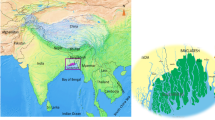Abstract
This chapter profoundly describes the legal framework right from the British period to the present times and the policies and strategies made by the central and the state government for conserving wilderness of the country in general and the state of Rajasthan in particular. The safeguard of forests has been included in the list of fundamental duties of the citizens of India in Article 51(g). The Wildlife (Protection) Act of 1972 and its implications along with the amendments of 1986, 1991, 2000, 2003, 2006, and 2008 have also been presented chronically in this chapter. Unfortunately, deforestation and other activities detrimental to nature conservation are still going on in the state due to the negligence of competent authorities in implementing the laws. The Government of India has also constituted the National Board of Wildlife, National Tiger Conservation Authority, Other Endangered Species Crime Control Bureau, and Tiger Conservation Foundation under various sections and Amendment Acts of the Wildlife Protection Act, 1972. Likewise, the state government has also constituted the State Board of Wildlife, Advisory Committee, Conservation Reserve Management Committee, Steering Committee for community reserves, State Biodiversity Board, Tiger Task Force, or State Empowerment Committee under these Acts. Under Section 4 of the Act, the state government has got the power to appoint an honorary wildlife warden. The implication of laws has been in bad shape during 1980–1995, a crucial period for wildlife particularly for the carnivores and Schedule I animals due to heavy demand from western countries for their fur, skin, bones, and meat. The ill-famed wildlife crime cases from the state are the Sansar Chand’s case of international wildlife smuggling responsible for the Sariska debacle, trade of critically endangered animals, Peregrine (resident species) and Shaheen falcon (migratory) on the border of Jaisalmer district, recovery of 250 kg elephant tusks (ivory) by the police in Jaipur, film star Salman Khan’s case for killing Blackbuck and Chinkara in Jodhpur district, and Kalia Bawaria case—a tribal responsible for the killings of a large number of panthers. Authors have also discussed the loopholes in the laws, taking advantage of which a maximum number of accused are discharged with minimum penalty and sentences.
Access this chapter
Tax calculation will be finalised at checkout
Purchases are for personal use only
Similar content being viewed by others
Suggested Reading
Ritwick D, Bhupendra Y (2005) Supreme Court on forest Conservation. Universal Law Publishing Company, Delhi, India, p 80.
Narayana PS (2001) Public Interest Litigation. Kamal Law House, Kolkata, India.
Desai Ashok (2002) Environment Jurisprudence, Modern Law House, Allahabad, India, p 480.
Rosenecraz A (1995) Environmental law and policy in India: Cases, materials and statutes. In: Armin Rosenecraz, Shyam Divan, Martha L Noble. (Reprt Eds). N M Tripathi Pvt. Ltd, Bombay, India, pp 555.
Mishra OP (2003) Public interest litigation and our rights, Diwedi Law Agency, Allahabad, India.
Paras D (2001) Environment Protection: Protection: Problems, Policy Administration, Law. Deep& Deep Publications Pvt Ltd, New Delhi, India.
Leela Krishnan P (1999) Environmental law in India. Butterworths, New Delhi, India, pp 194.
Shanta Kumar S (2005) Introduction to Environmental law. Surya Publications, Chennai, India, pp 677.
http://www.envfor.nic.in/legis/legis,html. for “India’s Forest Conservation Legislation: Acts, Rules, Guidelines”, from the Official website of: Government of India, Ministry of Environment & Forests.
Rules and Regulations. Official website of, Ministry of Environment and Forests, Government of India, Link: http://moef.nic.in/modules/rules-and-regulations/wildlife/
Dutta Ritwick, Raghuvanshi Vyom (2007) Commentaries on Wildlife Law- Cases, Statutes and Notifications. Wildlife Trust of India, pp 594.
Wildlife Crime: An Enforcement Guide. WPSI Publication, Delhi, India.
India’s Tiger Poaching Crisis. WPSI Publication, Delhi, India.
Menon Vivek, Sukumar Raman, Kumar Ashok (1998) A God in Distress: Threats of Poaching and the Ivory Trade to the Asian Elephant. A Wildlife Protection Society of India (WPSI) Publication. Delhi, India.
Official website of the Ministry of Environment and Forests, Government of India, Rules and Regulations. Link: http://moef.nic.in/modules/rules-and-regulations/wildlife/
Elizabeth John (2009) Identification sheets for wildlife species traded in South East Asia. In: Asian Wildlife Trade Bulletin of the Wild Life Trade Monitoring Network (TRAFFIC). 8. December.
Menon Vivek, Kumar Ashok (1999) Wildlife Crime: An Enforcement Guide. A Wildlife Protection Society of India (WPSI) Publication, pp 112.
Wright Belinda (1997) India’s Tiger Poaching Crisis.. A Wildlife Protection Society of India (WPSI) Publication.
Author information
Authors and Affiliations
Corresponding author
Editor information
Editors and Affiliations
Rights and permissions
Copyright information
© 2013 Springer International Publishing Switzerland
About this chapter
Cite this chapter
Sharma, B.K., Nathawat, B.S., Sharma, S., Kulshreshtha, S. (2013). Wildlife Conservation in Rajasthan: The Legal Framework Versus the Wildlife Trade. In: Sharma, B., Kulshreshtha, S., Rahmani, A. (eds) Faunal Heritage of Rajasthan, India. Springer, Cham. https://doi.org/10.1007/978-3-319-01345-9_19
Download citation
DOI: https://doi.org/10.1007/978-3-319-01345-9_19
Published:
Publisher Name: Springer, Cham
Print ISBN: 978-3-319-01344-2
Online ISBN: 978-3-319-01345-9
eBook Packages: Biomedical and Life SciencesBiomedical and Life Sciences (R0)




